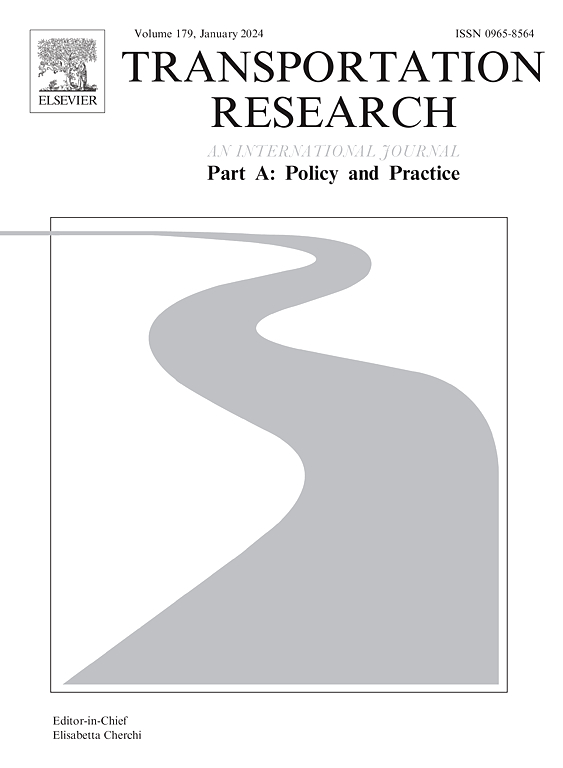制定 15 分钟城市政策?了解政策与物理障碍之间的差异
IF 6.3
1区 工程技术
Q1 ECONOMICS
Transportation Research Part A-Policy and Practice
Pub Date : 2024-11-12
DOI:10.1016/j.tra.2024.104307
引用次数: 0
摘要
x 分钟(或 15 分钟)城市的概念最近作为一种有影响力的城市规划方法而备受瞩目。最近的研究表明,美国、加拿大和澳大利亚的城市是如何利用不同的时间分界值和目的地类型来实现这一概念的。尽管如此,人们对不同的 15 分钟城市政策之间的可比性,以及城市中的物理要素在多大程度上会影响这一概念的实现却知之甚少。为了填补这一空白,本研究旨在了解这些政策之间的相似之处和不同之处,同时了解城市结构要素对实现这些政策的可能性的影响。本文利用萨斯卡通市的大量空间和交通数据,根据四种不同的城市规划,在地块层面上制定了五种不同的 15 分钟城市政策。利用汇总统计和多层次逻辑回归分析了以前的政策。研究表明,不同政策所得出的结论存在很大差异。例如,不同的政策在与人们的社会经济问题的关系方面导致了不同的结果,从而导致了公平评估。此外,研究还表明,一些物理要素,如高速公路、大型公园和铁路线,无论采用何种政策,都会对实现 15 分钟城市目标的概率产生一致的负面影响。其他要素则根据所使用的政策而产生不同的影响。这项研究让城市更好地了解不同 15 分钟城市政策的表现以及实现这些政策所面临的相对挑战,从而帮助城市实现更广泛的可持续发展和公平目标。本文章由计算机程序翻译,如有差异,请以英文原文为准。
Developing a 15-minute city policy? Understanding differences between policies and physical barriers
The concept of a x-minute (or 15-minute) city has recently gained prominence as an influential urban planning approach. Recent research showed how American, Canadian, and Australian cities operationalized the concept differently using diverse temporal cut-off values and types of destinations. Despite this, there has been little effort to understand how different 15-minute city policies are comparable, and to what extent physical elements in cities can affect realizing the concept. To address this gap, this study aims to understand parallels and differences between these policies while understanding the impacts of the city’s structuring elements on the probability of achieving them. Using a wide array of spatial and transportation data for the City of Saskatoon, the paper develops five different 15-minute city policies based on four different city plans at the parcel level. Using summary statistics and multilevel logistic regressions previous policies were analyzed. The study shows considerable differences between policies in terms of the conclusions they convey. For example, different policies led to diverse results regarding their relationship with people’s socioeconomic issues, and thereby equity assessment. Additionally, the study shows that some physical elements such as highways, large parks, and rail lines have a consistent negative impact on the probability of realizing 15-minute city goals, regardless of the used policy. Other elements had a mixed effect according to the used policy. This study offers cities a better understanding of the performance of different 15-minute city policies and the relative challenges in realizing them, helping cities achieve their broader sustainability and equity goals.
求助全文
通过发布文献求助,成功后即可免费获取论文全文。
去求助
来源期刊
CiteScore
13.20
自引率
7.80%
发文量
257
审稿时长
9.8 months
期刊介绍:
Transportation Research: Part A contains papers of general interest in all passenger and freight transportation modes: policy analysis, formulation and evaluation; planning; interaction with the political, socioeconomic and physical environment; design, management and evaluation of transportation systems. Topics are approached from any discipline or perspective: economics, engineering, sociology, psychology, etc. Case studies, survey and expository papers are included, as are articles which contribute to unification of the field, or to an understanding of the comparative aspects of different systems. Papers which assess the scope for technological innovation within a social or political framework are also published. The journal is international, and places equal emphasis on the problems of industrialized and non-industrialized regions.
Part A''s aims and scope are complementary to Transportation Research Part B: Methodological, Part C: Emerging Technologies and Part D: Transport and Environment. Part E: Logistics and Transportation Review. Part F: Traffic Psychology and Behaviour. The complete set forms the most cohesive and comprehensive reference of current research in transportation science.

 求助内容:
求助内容: 应助结果提醒方式:
应助结果提醒方式:


